Food Retailing: Industry Analysis and Consumer Impact Report
VerifiedAdded on 2020/06/05
|15
|5122
|42
Report
AI Summary
This report provides a comprehensive analysis of the food retailing industry, focusing on the UK market. It begins with an overview of the industry's size and structure, highlighting key players like Tesco, Marks & Spencer, and others, and categorizing different types of retail outlets. The report then delves into the types of products offered, providing examples from Tesco, McDonald's, and Subway, and detailing the scope of their food services. The core of the report examines the impact of consumer market developments, such as changing expectations, spending habits, cultural influences, and technological advancements, on the food retailing sector. It also explores the significance of health and safety legislation and its impact on the industry. Furthermore, the report discusses social, ethical, environmental, and corporate social responsibilities within food retailing. The report concludes by summarizing the key findings and implications for the industry's future. This report will aid in understanding way in which this industry functions and gets impacted by changing trends and laws imposed by the UK government.

Food Retailing
Paraphrase This Document
Need a fresh take? Get an instant paraphrase of this document with our AI Paraphraser
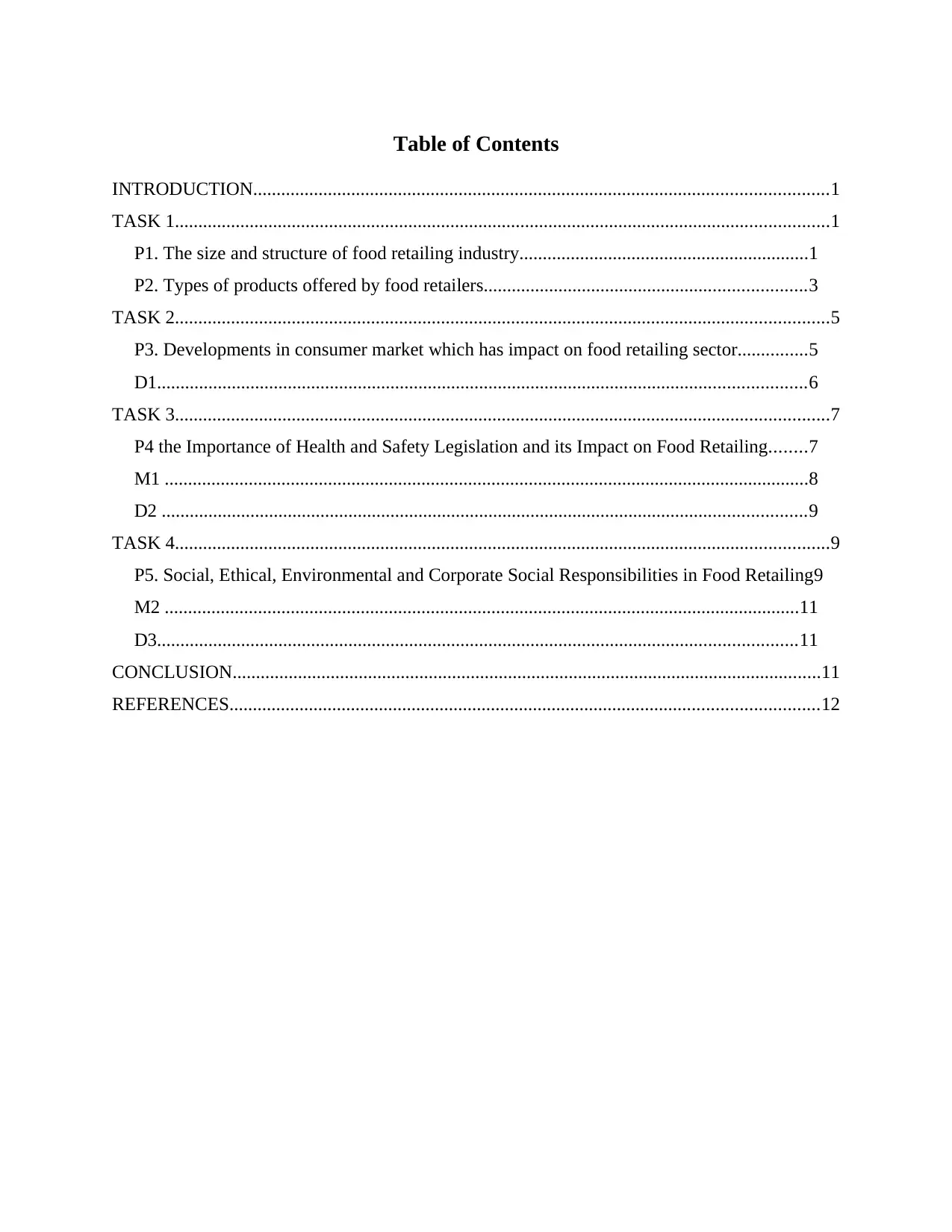
Table of Contents
INTRODUCTION...........................................................................................................................1
TASK 1............................................................................................................................................1
P1. The size and structure of food retailing industry..............................................................1
P2. Types of products offered by food retailers.....................................................................3
TASK 2............................................................................................................................................5
P3. Developments in consumer market which has impact on food retailing sector...............5
D1...........................................................................................................................................6
TASK 3............................................................................................................................................7
P4 the Importance of Health and Safety Legislation and its Impact on Food Retailing........7
M1 ..........................................................................................................................................8
D2 ..........................................................................................................................................9
TASK 4............................................................................................................................................9
P5. Social, Ethical, Environmental and Corporate Social Responsibilities in Food Retailing9
M2 ........................................................................................................................................11
D3.........................................................................................................................................11
CONCLUSION..............................................................................................................................11
REFERENCES..............................................................................................................................12
INTRODUCTION...........................................................................................................................1
TASK 1............................................................................................................................................1
P1. The size and structure of food retailing industry..............................................................1
P2. Types of products offered by food retailers.....................................................................3
TASK 2............................................................................................................................................5
P3. Developments in consumer market which has impact on food retailing sector...............5
D1...........................................................................................................................................6
TASK 3............................................................................................................................................7
P4 the Importance of Health and Safety Legislation and its Impact on Food Retailing........7
M1 ..........................................................................................................................................8
D2 ..........................................................................................................................................9
TASK 4............................................................................................................................................9
P5. Social, Ethical, Environmental and Corporate Social Responsibilities in Food Retailing9
M2 ........................................................................................................................................11
D3.........................................................................................................................................11
CONCLUSION..............................................................................................................................11
REFERENCES..............................................................................................................................12
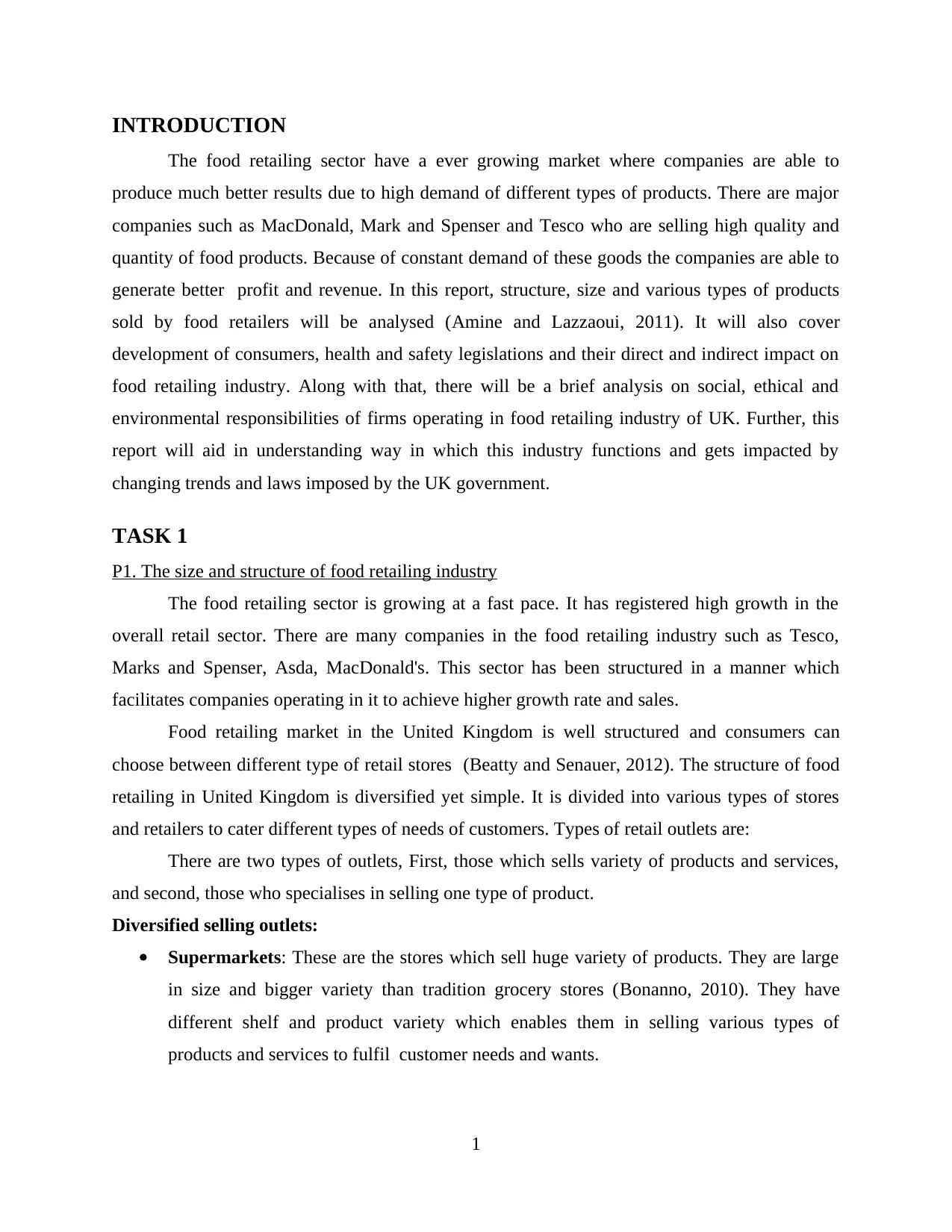
INTRODUCTION
The food retailing sector have a ever growing market where companies are able to
produce much better results due to high demand of different types of products. There are major
companies such as MacDonald, Mark and Spenser and Tesco who are selling high quality and
quantity of food products. Because of constant demand of these goods the companies are able to
generate better profit and revenue. In this report, structure, size and various types of products
sold by food retailers will be analysed (Amine and Lazzaoui, 2011). It will also cover
development of consumers, health and safety legislations and their direct and indirect impact on
food retailing industry. Along with that, there will be a brief analysis on social, ethical and
environmental responsibilities of firms operating in food retailing industry of UK. Further, this
report will aid in understanding way in which this industry functions and gets impacted by
changing trends and laws imposed by the UK government.
TASK 1
P1. The size and structure of food retailing industry
The food retailing sector is growing at a fast pace. It has registered high growth in the
overall retail sector. There are many companies in the food retailing industry such as Tesco,
Marks and Spenser, Asda, MacDonald's. This sector has been structured in a manner which
facilitates companies operating in it to achieve higher growth rate and sales.
Food retailing market in the United Kingdom is well structured and consumers can
choose between different type of retail stores (Beatty and Senauer, 2012). The structure of food
retailing in United Kingdom is diversified yet simple. It is divided into various types of stores
and retailers to cater different types of needs of customers. Types of retail outlets are:
There are two types of outlets, First, those which sells variety of products and services,
and second, those who specialises in selling one type of product.
Diversified selling outlets:
Supermarkets: These are the stores which sell huge variety of products. They are large
in size and bigger variety than tradition grocery stores (Bonanno, 2010). They have
different shelf and product variety which enables them in selling various types of
products and services to fulfil customer needs and wants.
1
The food retailing sector have a ever growing market where companies are able to
produce much better results due to high demand of different types of products. There are major
companies such as MacDonald, Mark and Spenser and Tesco who are selling high quality and
quantity of food products. Because of constant demand of these goods the companies are able to
generate better profit and revenue. In this report, structure, size and various types of products
sold by food retailers will be analysed (Amine and Lazzaoui, 2011). It will also cover
development of consumers, health and safety legislations and their direct and indirect impact on
food retailing industry. Along with that, there will be a brief analysis on social, ethical and
environmental responsibilities of firms operating in food retailing industry of UK. Further, this
report will aid in understanding way in which this industry functions and gets impacted by
changing trends and laws imposed by the UK government.
TASK 1
P1. The size and structure of food retailing industry
The food retailing sector is growing at a fast pace. It has registered high growth in the
overall retail sector. There are many companies in the food retailing industry such as Tesco,
Marks and Spenser, Asda, MacDonald's. This sector has been structured in a manner which
facilitates companies operating in it to achieve higher growth rate and sales.
Food retailing market in the United Kingdom is well structured and consumers can
choose between different type of retail stores (Beatty and Senauer, 2012). The structure of food
retailing in United Kingdom is diversified yet simple. It is divided into various types of stores
and retailers to cater different types of needs of customers. Types of retail outlets are:
There are two types of outlets, First, those which sells variety of products and services,
and second, those who specialises in selling one type of product.
Diversified selling outlets:
Supermarkets: These are the stores which sell huge variety of products. They are large
in size and bigger variety than tradition grocery stores (Bonanno, 2010). They have
different shelf and product variety which enables them in selling various types of
products and services to fulfil customer needs and wants.
1
⊘ This is a preview!⊘
Do you want full access?
Subscribe today to unlock all pages.

Trusted by 1+ million students worldwide
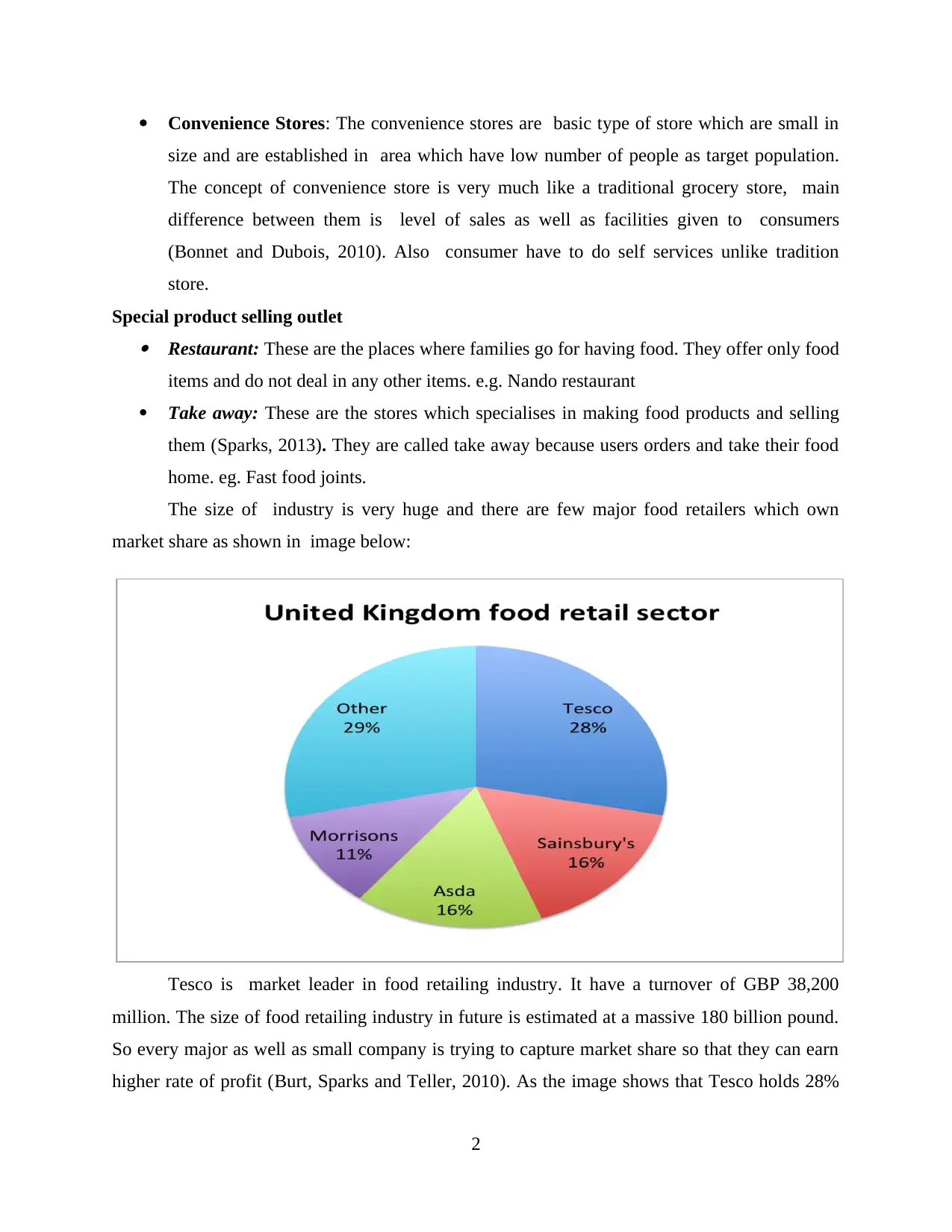
Convenience Stores: The convenience stores are basic type of store which are small in
size and are established in area which have low number of people as target population.
The concept of convenience store is very much like a traditional grocery store, main
difference between them is level of sales as well as facilities given to consumers
(Bonnet and Dubois, 2010). Also consumer have to do self services unlike tradition
store.
Special product selling outlet Restaurant: These are the places where families go for having food. They offer only food
items and do not deal in any other items. e.g. Nando restaurant
Take away: These are the stores which specialises in making food products and selling
them (Sparks, 2013). They are called take away because users orders and take their food
home. eg. Fast food joints.
The size of industry is very huge and there are few major food retailers which own
market share as shown in image below:
Tesco is market leader in food retailing industry. It have a turnover of GBP 38,200
million. The size of food retailing industry in future is estimated at a massive 180 billion pound.
So every major as well as small company is trying to capture market share so that they can earn
higher rate of profit (Burt, Sparks and Teller, 2010). As the image shows that Tesco holds 28%
2
size and are established in area which have low number of people as target population.
The concept of convenience store is very much like a traditional grocery store, main
difference between them is level of sales as well as facilities given to consumers
(Bonnet and Dubois, 2010). Also consumer have to do self services unlike tradition
store.
Special product selling outlet Restaurant: These are the places where families go for having food. They offer only food
items and do not deal in any other items. e.g. Nando restaurant
Take away: These are the stores which specialises in making food products and selling
them (Sparks, 2013). They are called take away because users orders and take their food
home. eg. Fast food joints.
The size of industry is very huge and there are few major food retailers which own
market share as shown in image below:
Tesco is market leader in food retailing industry. It have a turnover of GBP 38,200
million. The size of food retailing industry in future is estimated at a massive 180 billion pound.
So every major as well as small company is trying to capture market share so that they can earn
higher rate of profit (Burt, Sparks and Teller, 2010). As the image shows that Tesco holds 28%
2
Paraphrase This Document
Need a fresh take? Get an instant paraphrase of this document with our AI Paraphraser
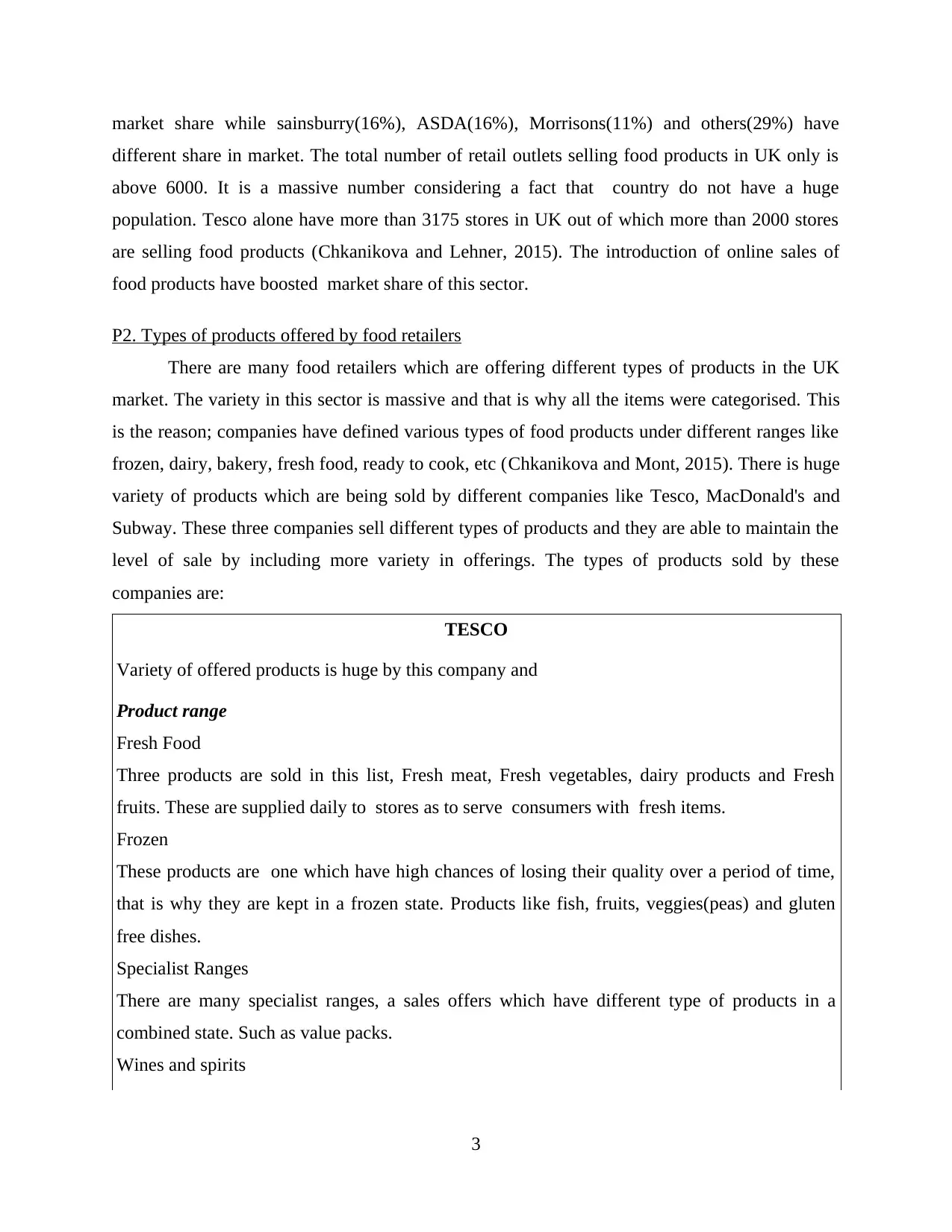
market share while sainsburry(16%), ASDA(16%), Morrisons(11%) and others(29%) have
different share in market. The total number of retail outlets selling food products in UK only is
above 6000. It is a massive number considering a fact that country do not have a huge
population. Tesco alone have more than 3175 stores in UK out of which more than 2000 stores
are selling food products (Chkanikova and Lehner, 2015). The introduction of online sales of
food products have boosted market share of this sector.
P2. Types of products offered by food retailers
There are many food retailers which are offering different types of products in the UK
market. The variety in this sector is massive and that is why all the items were categorised. This
is the reason; companies have defined various types of food products under different ranges like
frozen, dairy, bakery, fresh food, ready to cook, etc (Chkanikova and Mont, 2015). There is huge
variety of products which are being sold by different companies like Tesco, MacDonald's and
Subway. These three companies sell different types of products and they are able to maintain the
level of sale by including more variety in offerings. The types of products sold by these
companies are:
TESCO
Variety of offered products is huge by this company and
Product range
Fresh Food
Three products are sold in this list, Fresh meat, Fresh vegetables, dairy products and Fresh
fruits. These are supplied daily to stores as to serve consumers with fresh items.
Frozen
These products are one which have high chances of losing their quality over a period of time,
that is why they are kept in a frozen state. Products like fish, fruits, veggies(peas) and gluten
free dishes.
Specialist Ranges
There are many specialist ranges, a sales offers which have different type of products in a
combined state. Such as value packs.
Wines and spirits
3
different share in market. The total number of retail outlets selling food products in UK only is
above 6000. It is a massive number considering a fact that country do not have a huge
population. Tesco alone have more than 3175 stores in UK out of which more than 2000 stores
are selling food products (Chkanikova and Lehner, 2015). The introduction of online sales of
food products have boosted market share of this sector.
P2. Types of products offered by food retailers
There are many food retailers which are offering different types of products in the UK
market. The variety in this sector is massive and that is why all the items were categorised. This
is the reason; companies have defined various types of food products under different ranges like
frozen, dairy, bakery, fresh food, ready to cook, etc (Chkanikova and Mont, 2015). There is huge
variety of products which are being sold by different companies like Tesco, MacDonald's and
Subway. These three companies sell different types of products and they are able to maintain the
level of sale by including more variety in offerings. The types of products sold by these
companies are:
TESCO
Variety of offered products is huge by this company and
Product range
Fresh Food
Three products are sold in this list, Fresh meat, Fresh vegetables, dairy products and Fresh
fruits. These are supplied daily to stores as to serve consumers with fresh items.
Frozen
These products are one which have high chances of losing their quality over a period of time,
that is why they are kept in a frozen state. Products like fish, fruits, veggies(peas) and gluten
free dishes.
Specialist Ranges
There are many specialist ranges, a sales offers which have different type of products in a
combined state. Such as value packs.
Wines and spirits
3
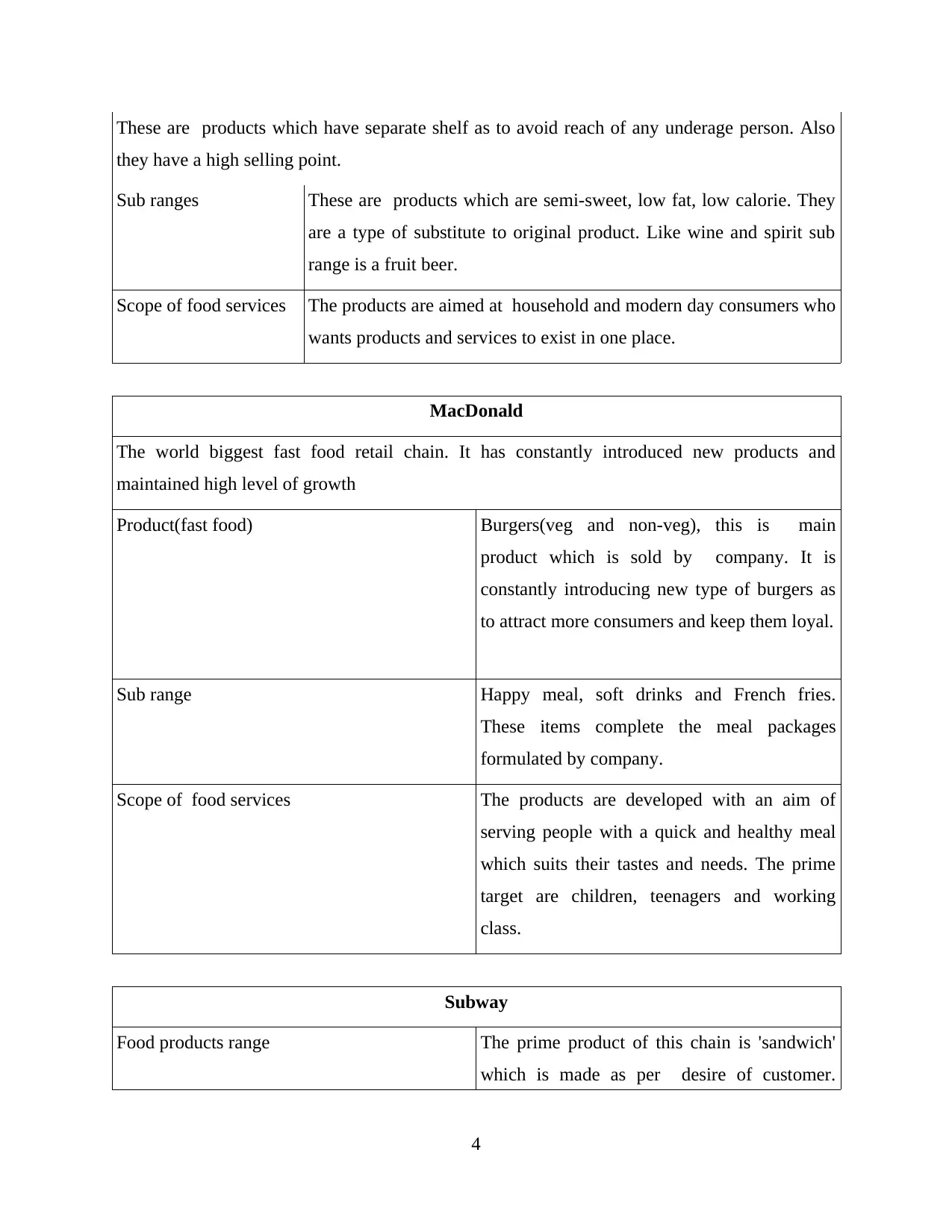
These are products which have separate shelf as to avoid reach of any underage person. Also
they have a high selling point.
Sub ranges These are products which are semi-sweet, low fat, low calorie. They
are a type of substitute to original product. Like wine and spirit sub
range is a fruit beer.
Scope of food services The products are aimed at household and modern day consumers who
wants products and services to exist in one place.
MacDonald
The world biggest fast food retail chain. It has constantly introduced new products and
maintained high level of growth
Product(fast food) Burgers(veg and non-veg), this is main
product which is sold by company. It is
constantly introducing new type of burgers as
to attract more consumers and keep them loyal.
Sub range Happy meal, soft drinks and French fries.
These items complete the meal packages
formulated by company.
Scope of food services The products are developed with an aim of
serving people with a quick and healthy meal
which suits their tastes and needs. The prime
target are children, teenagers and working
class.
Subway
Food products range The prime product of this chain is 'sandwich'
which is made as per desire of customer.
4
they have a high selling point.
Sub ranges These are products which are semi-sweet, low fat, low calorie. They
are a type of substitute to original product. Like wine and spirit sub
range is a fruit beer.
Scope of food services The products are aimed at household and modern day consumers who
wants products and services to exist in one place.
MacDonald
The world biggest fast food retail chain. It has constantly introduced new products and
maintained high level of growth
Product(fast food) Burgers(veg and non-veg), this is main
product which is sold by company. It is
constantly introducing new type of burgers as
to attract more consumers and keep them loyal.
Sub range Happy meal, soft drinks and French fries.
These items complete the meal packages
formulated by company.
Scope of food services The products are developed with an aim of
serving people with a quick and healthy meal
which suits their tastes and needs. The prime
target are children, teenagers and working
class.
Subway
Food products range The prime product of this chain is 'sandwich'
which is made as per desire of customer.
4
⊘ This is a preview!⊘
Do you want full access?
Subscribe today to unlock all pages.

Trusted by 1+ million students worldwide

There are different types of toppings which are
available for customers and they can choose
from them.
Sub-range The supporting items are desserts, soft drinks
and burgers. These help the company in
ensuring that the consumers have full meal.
Scope of food services The main target of company are people who
want customised food items. They have
products which can cater to the needs of
children and adults both.
These firms are totally different when comes to products and offerings to customers. The
scope of food services is totally different. Tesco is targeting household needs and wants, on the
other hand MacDonald and Subway are targeting people with their fast food and customisable
food items (Tedlow and Jones, 2014). The market is full of different products that are constantly
being introduced by organisations just to keep customers engaged. Food market is forecasted to
overshadow whole the retail sector with its high growth rate.
TASK 2
P3. Developments in consumer market which has impact on food retailing sector
In the current scenario, many changes have taken place in the market like consumers'
demand, their spending power, culture, lifestyle, etc. that affect food retailing industry to a high
extent. TESCO needs to change as per new environment, so that it can meet requirement of it's
consumers (Cummins, 2014). Customers always want to get high quality of products at
economic price and so for giving the same, company has adopted latest technology so that it can
focus on the quality and price of goods and can capture a large market share.
At present, retailers provide services to its end users for 24*7 hour so that requirements
of target market can be met on time and provide best services against competitors can be
provided. Every customers wants to get discount on purchasing so TESCO should offer various
types of promotional offers so that consumers can be attracted (Das, 2014). There are various
impacts of developments on food retailing which are stated as follows:
5
available for customers and they can choose
from them.
Sub-range The supporting items are desserts, soft drinks
and burgers. These help the company in
ensuring that the consumers have full meal.
Scope of food services The main target of company are people who
want customised food items. They have
products which can cater to the needs of
children and adults both.
These firms are totally different when comes to products and offerings to customers. The
scope of food services is totally different. Tesco is targeting household needs and wants, on the
other hand MacDonald and Subway are targeting people with their fast food and customisable
food items (Tedlow and Jones, 2014). The market is full of different products that are constantly
being introduced by organisations just to keep customers engaged. Food market is forecasted to
overshadow whole the retail sector with its high growth rate.
TASK 2
P3. Developments in consumer market which has impact on food retailing sector
In the current scenario, many changes have taken place in the market like consumers'
demand, their spending power, culture, lifestyle, etc. that affect food retailing industry to a high
extent. TESCO needs to change as per new environment, so that it can meet requirement of it's
consumers (Cummins, 2014). Customers always want to get high quality of products at
economic price and so for giving the same, company has adopted latest technology so that it can
focus on the quality and price of goods and can capture a large market share.
At present, retailers provide services to its end users for 24*7 hour so that requirements
of target market can be met on time and provide best services against competitors can be
provided. Every customers wants to get discount on purchasing so TESCO should offer various
types of promotional offers so that consumers can be attracted (Das, 2014). There are various
impacts of developments on food retailing which are stated as follows:
5
Paraphrase This Document
Need a fresh take? Get an instant paraphrase of this document with our AI Paraphraser

Customer’s expectations and demand- In the present scenario, customer’s expectations
and their demand are changing that highly affect food retailing (Senauer and Seltzer,
2010). So, TESCO should deliver the services according to their expectations and
increase their efficiency and productivity so that it can serve them effectively.
Higher consumer spending- Today, end users are spending more for purchasing high
quality of products and price does not matter to them as what they want is high quality
(Chkanikova and Lehner, 2015). It results in increasing the demand of products and sales
of company. So, organisation should focus on the quality of merchandise.
Cultural and lifestyle expectations- These also affect food retailing because everyone
takes goods and services according to their culture and lifestyle (Eckert and Shetty,
2011). So, TESCO should keep in mind the civilization and manner of its target market
so that it can meet with the requirement of customers.
Technology- Food retailer should adopt the latest technology for providing high quality
services to its target market because it will help in retaining customers for a longer period
of time. Latest technologies like bar coding, scanning, loyalty cards, etc. prove to be
helpful for increasing demand and thus, the revenue of company.
Customer services- TESCO should focus on rendering quality customer service so that it
can capture a large market share (Friedrich, 2010). It will help in building a positive
brand image in the minds of customers as well.
Focused marketing and purchasing- TESCO should focus on marketing activities so
that awareness about its merchandise can be created in target market and customers
towards the given offers can be attracted. These activities are helpful in increasing sales
and profits as well as help in capturing high market share with competitive advantages
over others.
Seasonal changes- These are the changes which taken place with season. In winter the
demand for products are consumed warm increases while in summers the sell of soft
drinks get a boost (Gorton, Sauer and Supatpongkul, 2011). Company has to provide
products and services as per the season and demand of food items.
D1
Consumer market is increasing continuously in numerous ways. It is happening because
of development that is taking place in technology, environment, global change, culture and new
6
and their demand are changing that highly affect food retailing (Senauer and Seltzer,
2010). So, TESCO should deliver the services according to their expectations and
increase their efficiency and productivity so that it can serve them effectively.
Higher consumer spending- Today, end users are spending more for purchasing high
quality of products and price does not matter to them as what they want is high quality
(Chkanikova and Lehner, 2015). It results in increasing the demand of products and sales
of company. So, organisation should focus on the quality of merchandise.
Cultural and lifestyle expectations- These also affect food retailing because everyone
takes goods and services according to their culture and lifestyle (Eckert and Shetty,
2011). So, TESCO should keep in mind the civilization and manner of its target market
so that it can meet with the requirement of customers.
Technology- Food retailer should adopt the latest technology for providing high quality
services to its target market because it will help in retaining customers for a longer period
of time. Latest technologies like bar coding, scanning, loyalty cards, etc. prove to be
helpful for increasing demand and thus, the revenue of company.
Customer services- TESCO should focus on rendering quality customer service so that it
can capture a large market share (Friedrich, 2010). It will help in building a positive
brand image in the minds of customers as well.
Focused marketing and purchasing- TESCO should focus on marketing activities so
that awareness about its merchandise can be created in target market and customers
towards the given offers can be attracted. These activities are helpful in increasing sales
and profits as well as help in capturing high market share with competitive advantages
over others.
Seasonal changes- These are the changes which taken place with season. In winter the
demand for products are consumed warm increases while in summers the sell of soft
drinks get a boost (Gorton, Sauer and Supatpongkul, 2011). Company has to provide
products and services as per the season and demand of food items.
D1
Consumer market is increasing continuously in numerous ways. It is happening because
of development that is taking place in technology, environment, global change, culture and new
6
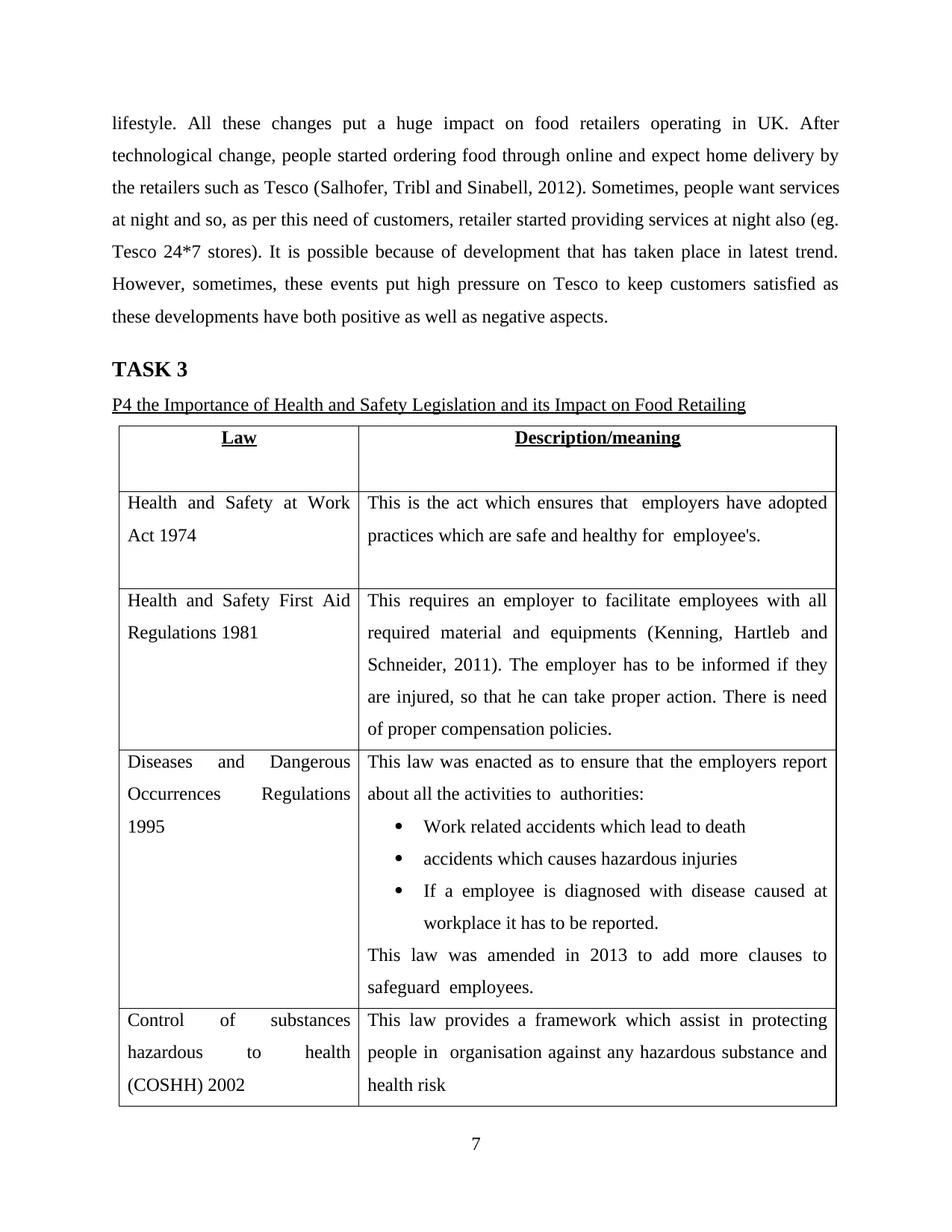
lifestyle. All these changes put a huge impact on food retailers operating in UK. After
technological change, people started ordering food through online and expect home delivery by
the retailers such as Tesco (Salhofer, Tribl and Sinabell, 2012). Sometimes, people want services
at night and so, as per this need of customers, retailer started providing services at night also (eg.
Tesco 24*7 stores). It is possible because of development that has taken place in latest trend.
However, sometimes, these events put high pressure on Tesco to keep customers satisfied as
these developments have both positive as well as negative aspects.
TASK 3
P4 the Importance of Health and Safety Legislation and its Impact on Food Retailing
Law Description/meaning
Health and Safety at Work
Act 1974
This is the act which ensures that employers have adopted
practices which are safe and healthy for employee's.
Health and Safety First Aid
Regulations 1981
This requires an employer to facilitate employees with all
required material and equipments (Kenning, Hartleb and
Schneider, 2011). The employer has to be informed if they
are injured, so that he can take proper action. There is need
of proper compensation policies.
Diseases and Dangerous
Occurrences Regulations
1995
This law was enacted as to ensure that the employers report
about all the activities to authorities:
Work related accidents which lead to death
accidents which causes hazardous injuries
If a employee is diagnosed with disease caused at
workplace it has to be reported.
This law was amended in 2013 to add more clauses to
safeguard employees.
Control of substances
hazardous to health
(COSHH) 2002
This law provides a framework which assist in protecting
people in organisation against any hazardous substance and
health risk
7
technological change, people started ordering food through online and expect home delivery by
the retailers such as Tesco (Salhofer, Tribl and Sinabell, 2012). Sometimes, people want services
at night and so, as per this need of customers, retailer started providing services at night also (eg.
Tesco 24*7 stores). It is possible because of development that has taken place in latest trend.
However, sometimes, these events put high pressure on Tesco to keep customers satisfied as
these developments have both positive as well as negative aspects.
TASK 3
P4 the Importance of Health and Safety Legislation and its Impact on Food Retailing
Law Description/meaning
Health and Safety at Work
Act 1974
This is the act which ensures that employers have adopted
practices which are safe and healthy for employee's.
Health and Safety First Aid
Regulations 1981
This requires an employer to facilitate employees with all
required material and equipments (Kenning, Hartleb and
Schneider, 2011). The employer has to be informed if they
are injured, so that he can take proper action. There is need
of proper compensation policies.
Diseases and Dangerous
Occurrences Regulations
1995
This law was enacted as to ensure that the employers report
about all the activities to authorities:
Work related accidents which lead to death
accidents which causes hazardous injuries
If a employee is diagnosed with disease caused at
workplace it has to be reported.
This law was amended in 2013 to add more clauses to
safeguard employees.
Control of substances
hazardous to health
(COSHH) 2002
This law provides a framework which assist in protecting
people in organisation against any hazardous substance and
health risk
7
⊘ This is a preview!⊘
Do you want full access?
Subscribe today to unlock all pages.

Trusted by 1+ million students worldwide
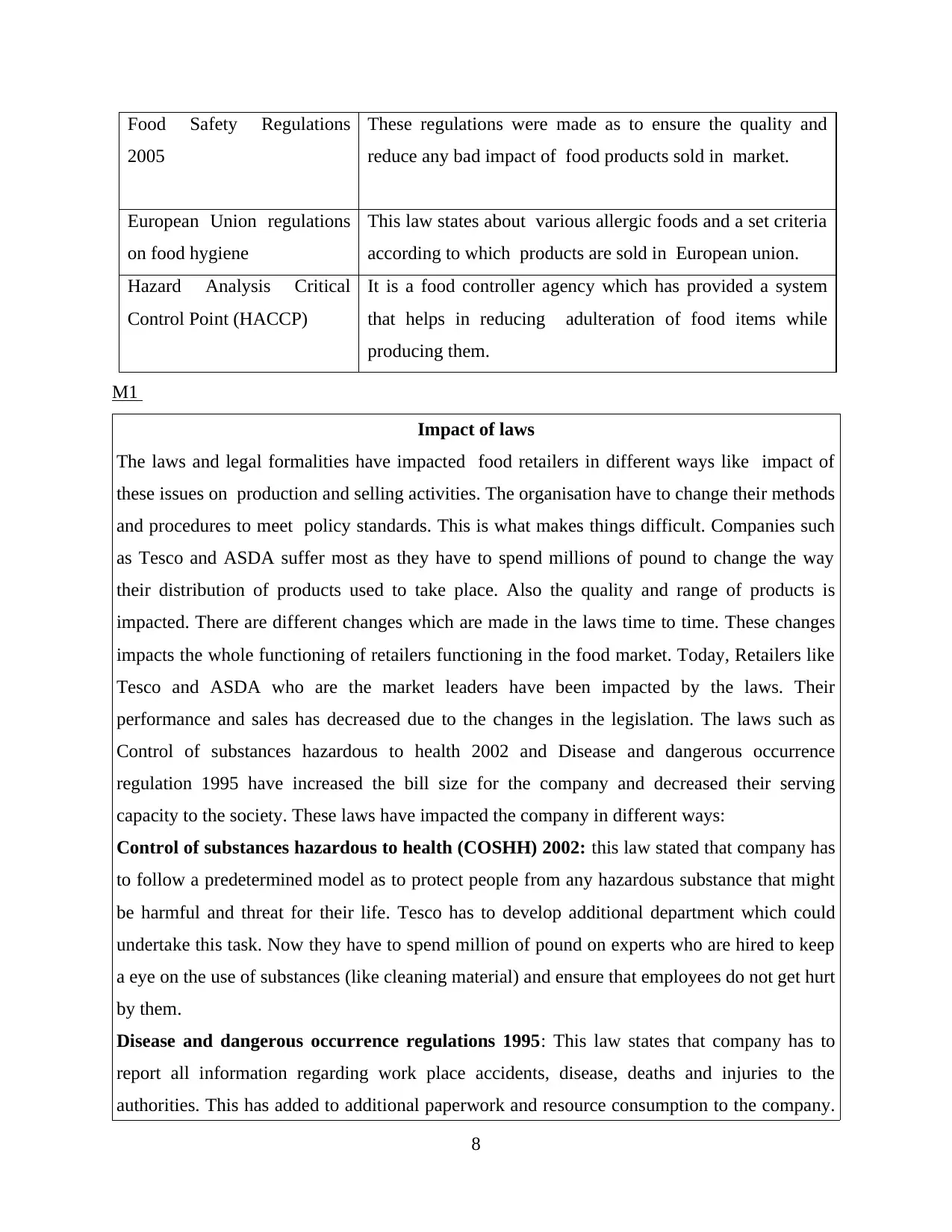
Food Safety Regulations
2005
These regulations were made as to ensure the quality and
reduce any bad impact of food products sold in market.
European Union regulations
on food hygiene
This law states about various allergic foods and a set criteria
according to which products are sold in European union.
Hazard Analysis Critical
Control Point (HACCP)
It is a food controller agency which has provided a system
that helps in reducing adulteration of food items while
producing them.
M1
Impact of laws
The laws and legal formalities have impacted food retailers in different ways like impact of
these issues on production and selling activities. The organisation have to change their methods
and procedures to meet policy standards. This is what makes things difficult. Companies such
as Tesco and ASDA suffer most as they have to spend millions of pound to change the way
their distribution of products used to take place. Also the quality and range of products is
impacted. There are different changes which are made in the laws time to time. These changes
impacts the whole functioning of retailers functioning in the food market. Today, Retailers like
Tesco and ASDA who are the market leaders have been impacted by the laws. Their
performance and sales has decreased due to the changes in the legislation. The laws such as
Control of substances hazardous to health 2002 and Disease and dangerous occurrence
regulation 1995 have increased the bill size for the company and decreased their serving
capacity to the society. These laws have impacted the company in different ways:
Control of substances hazardous to health (COSHH) 2002: this law stated that company has
to follow a predetermined model as to protect people from any hazardous substance that might
be harmful and threat for their life. Tesco has to develop additional department which could
undertake this task. Now they have to spend million of pound on experts who are hired to keep
a eye on the use of substances (like cleaning material) and ensure that employees do not get hurt
by them.
Disease and dangerous occurrence regulations 1995: This law states that company has to
report all information regarding work place accidents, disease, deaths and injuries to the
authorities. This has added to additional paperwork and resource consumption to the company.
8
2005
These regulations were made as to ensure the quality and
reduce any bad impact of food products sold in market.
European Union regulations
on food hygiene
This law states about various allergic foods and a set criteria
according to which products are sold in European union.
Hazard Analysis Critical
Control Point (HACCP)
It is a food controller agency which has provided a system
that helps in reducing adulteration of food items while
producing them.
M1
Impact of laws
The laws and legal formalities have impacted food retailers in different ways like impact of
these issues on production and selling activities. The organisation have to change their methods
and procedures to meet policy standards. This is what makes things difficult. Companies such
as Tesco and ASDA suffer most as they have to spend millions of pound to change the way
their distribution of products used to take place. Also the quality and range of products is
impacted. There are different changes which are made in the laws time to time. These changes
impacts the whole functioning of retailers functioning in the food market. Today, Retailers like
Tesco and ASDA who are the market leaders have been impacted by the laws. Their
performance and sales has decreased due to the changes in the legislation. The laws such as
Control of substances hazardous to health 2002 and Disease and dangerous occurrence
regulation 1995 have increased the bill size for the company and decreased their serving
capacity to the society. These laws have impacted the company in different ways:
Control of substances hazardous to health (COSHH) 2002: this law stated that company has
to follow a predetermined model as to protect people from any hazardous substance that might
be harmful and threat for their life. Tesco has to develop additional department which could
undertake this task. Now they have to spend million of pound on experts who are hired to keep
a eye on the use of substances (like cleaning material) and ensure that employees do not get hurt
by them.
Disease and dangerous occurrence regulations 1995: This law states that company has to
report all information regarding work place accidents, disease, deaths and injuries to the
authorities. This has added to additional paperwork and resource consumption to the company.
8
Paraphrase This Document
Need a fresh take? Get an instant paraphrase of this document with our AI Paraphraser
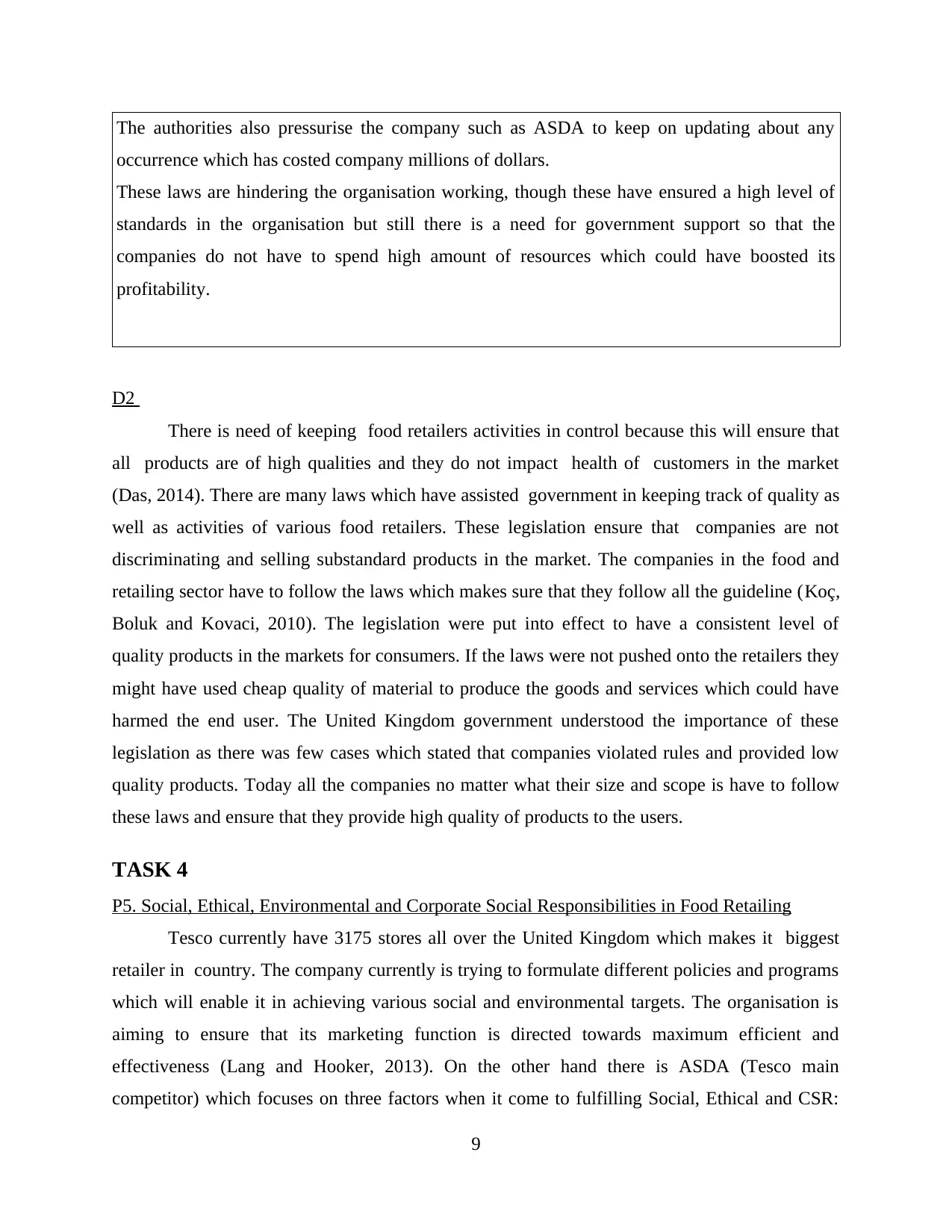
The authorities also pressurise the company such as ASDA to keep on updating about any
occurrence which has costed company millions of dollars.
These laws are hindering the organisation working, though these have ensured a high level of
standards in the organisation but still there is a need for government support so that the
companies do not have to spend high amount of resources which could have boosted its
profitability.
D2
There is need of keeping food retailers activities in control because this will ensure that
all products are of high qualities and they do not impact health of customers in the market
(Das, 2014). There are many laws which have assisted government in keeping track of quality as
well as activities of various food retailers. These legislation ensure that companies are not
discriminating and selling substandard products in the market. The companies in the food and
retailing sector have to follow the laws which makes sure that they follow all the guideline (Koç,
Boluk and Kovaci, 2010). The legislation were put into effect to have a consistent level of
quality products in the markets for consumers. If the laws were not pushed onto the retailers they
might have used cheap quality of material to produce the goods and services which could have
harmed the end user. The United Kingdom government understood the importance of these
legislation as there was few cases which stated that companies violated rules and provided low
quality products. Today all the companies no matter what their size and scope is have to follow
these laws and ensure that they provide high quality of products to the users.
TASK 4
P5. Social, Ethical, Environmental and Corporate Social Responsibilities in Food Retailing
Tesco currently have 3175 stores all over the United Kingdom which makes it biggest
retailer in country. The company currently is trying to formulate different policies and programs
which will enable it in achieving various social and environmental targets. The organisation is
aiming to ensure that its marketing function is directed towards maximum efficient and
effectiveness (Lang and Hooker, 2013). On the other hand there is ASDA (Tesco main
competitor) which focuses on three factors when it come to fulfilling Social, Ethical and CSR:
9
occurrence which has costed company millions of dollars.
These laws are hindering the organisation working, though these have ensured a high level of
standards in the organisation but still there is a need for government support so that the
companies do not have to spend high amount of resources which could have boosted its
profitability.
D2
There is need of keeping food retailers activities in control because this will ensure that
all products are of high qualities and they do not impact health of customers in the market
(Das, 2014). There are many laws which have assisted government in keeping track of quality as
well as activities of various food retailers. These legislation ensure that companies are not
discriminating and selling substandard products in the market. The companies in the food and
retailing sector have to follow the laws which makes sure that they follow all the guideline (Koç,
Boluk and Kovaci, 2010). The legislation were put into effect to have a consistent level of
quality products in the markets for consumers. If the laws were not pushed onto the retailers they
might have used cheap quality of material to produce the goods and services which could have
harmed the end user. The United Kingdom government understood the importance of these
legislation as there was few cases which stated that companies violated rules and provided low
quality products. Today all the companies no matter what their size and scope is have to follow
these laws and ensure that they provide high quality of products to the users.
TASK 4
P5. Social, Ethical, Environmental and Corporate Social Responsibilities in Food Retailing
Tesco currently have 3175 stores all over the United Kingdom which makes it biggest
retailer in country. The company currently is trying to formulate different policies and programs
which will enable it in achieving various social and environmental targets. The organisation is
aiming to ensure that its marketing function is directed towards maximum efficient and
effectiveness (Lang and Hooker, 2013). On the other hand there is ASDA (Tesco main
competitor) which focuses on three factors when it come to fulfilling Social, Ethical and CSR:
9
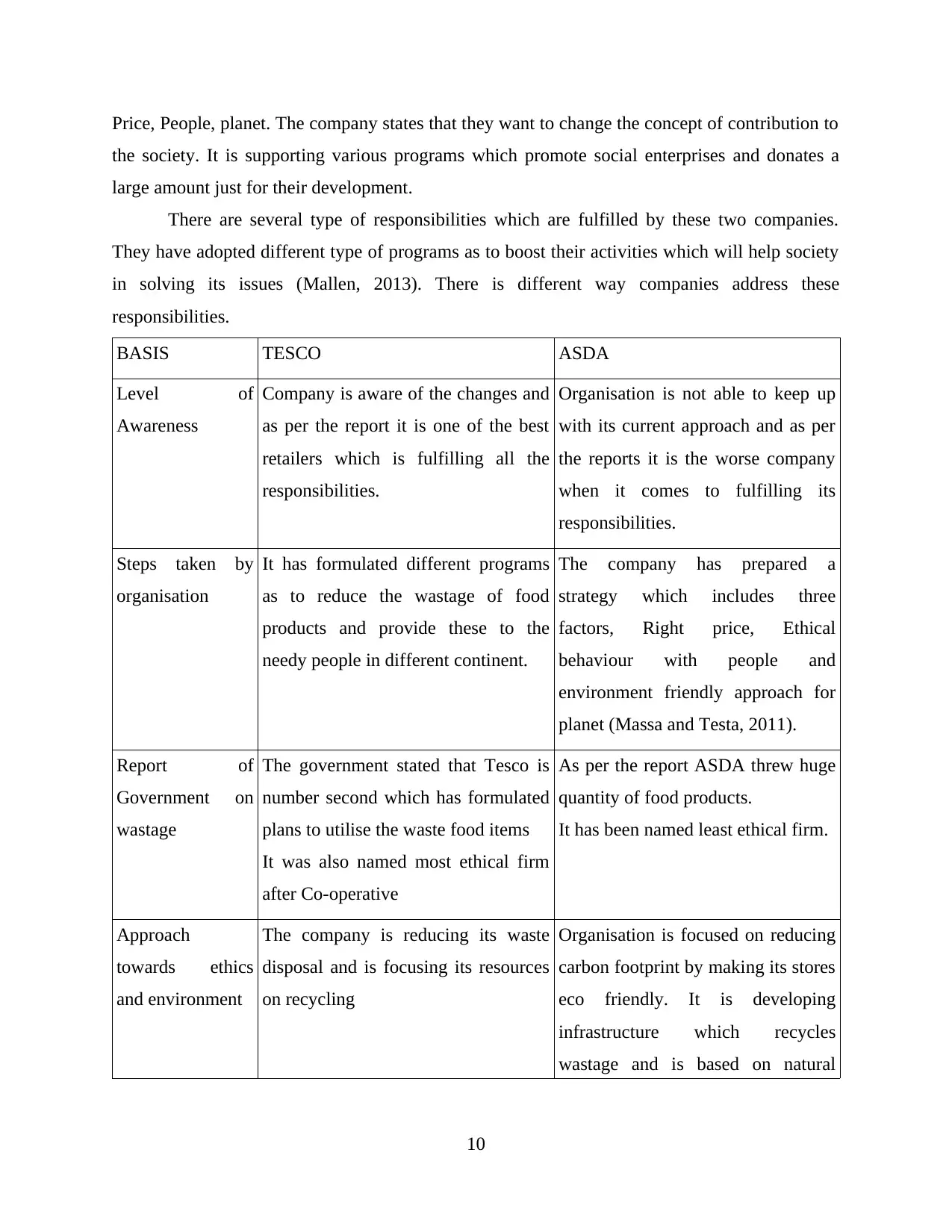
Price, People, planet. The company states that they want to change the concept of contribution to
the society. It is supporting various programs which promote social enterprises and donates a
large amount just for their development.
There are several type of responsibilities which are fulfilled by these two companies.
They have adopted different type of programs as to boost their activities which will help society
in solving its issues (Mallen, 2013). There is different way companies address these
responsibilities.
BASIS TESCO ASDA
Level of
Awareness
Company is aware of the changes and
as per the report it is one of the best
retailers which is fulfilling all the
responsibilities.
Organisation is not able to keep up
with its current approach and as per
the reports it is the worse company
when it comes to fulfilling its
responsibilities.
Steps taken by
organisation
It has formulated different programs
as to reduce the wastage of food
products and provide these to the
needy people in different continent.
The company has prepared a
strategy which includes three
factors, Right price, Ethical
behaviour with people and
environment friendly approach for
planet (Massa and Testa, 2011).
Report of
Government on
wastage
The government stated that Tesco is
number second which has formulated
plans to utilise the waste food items
It was also named most ethical firm
after Co-operative
As per the report ASDA threw huge
quantity of food products.
It has been named least ethical firm.
Approach
towards ethics
and environment
The company is reducing its waste
disposal and is focusing its resources
on recycling
Organisation is focused on reducing
carbon footprint by making its stores
eco friendly. It is developing
infrastructure which recycles
wastage and is based on natural
10
the society. It is supporting various programs which promote social enterprises and donates a
large amount just for their development.
There are several type of responsibilities which are fulfilled by these two companies.
They have adopted different type of programs as to boost their activities which will help society
in solving its issues (Mallen, 2013). There is different way companies address these
responsibilities.
BASIS TESCO ASDA
Level of
Awareness
Company is aware of the changes and
as per the report it is one of the best
retailers which is fulfilling all the
responsibilities.
Organisation is not able to keep up
with its current approach and as per
the reports it is the worse company
when it comes to fulfilling its
responsibilities.
Steps taken by
organisation
It has formulated different programs
as to reduce the wastage of food
products and provide these to the
needy people in different continent.
The company has prepared a
strategy which includes three
factors, Right price, Ethical
behaviour with people and
environment friendly approach for
planet (Massa and Testa, 2011).
Report of
Government on
wastage
The government stated that Tesco is
number second which has formulated
plans to utilise the waste food items
It was also named most ethical firm
after Co-operative
As per the report ASDA threw huge
quantity of food products.
It has been named least ethical firm.
Approach
towards ethics
and environment
The company is reducing its waste
disposal and is focusing its resources
on recycling
Organisation is focused on reducing
carbon footprint by making its stores
eco friendly. It is developing
infrastructure which recycles
wastage and is based on natural
10
⊘ This is a preview!⊘
Do you want full access?
Subscribe today to unlock all pages.

Trusted by 1+ million students worldwide
1 out of 15
Related Documents
Your All-in-One AI-Powered Toolkit for Academic Success.
+13062052269
info@desklib.com
Available 24*7 on WhatsApp / Email
![[object Object]](/_next/static/media/star-bottom.7253800d.svg)
Unlock your academic potential
Copyright © 2020–2025 A2Z Services. All Rights Reserved. Developed and managed by ZUCOL.





